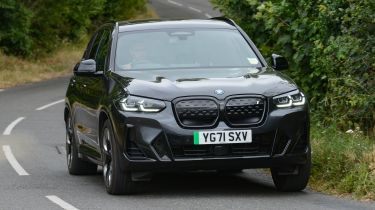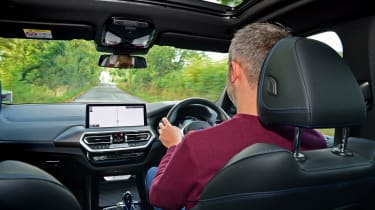BMW iX3 review: performance, motor & drive
Despite being down on power compared with some rivals, the BMW iX3 feels fast and quite good fun; the ride is a little firm, though
| 0-62mph | Top speed | Driven wheels | Power |
|---|---|---|---|
| 6.8s | 112mph | Rear | 282bhp |
Regardless of whether it's petrol, diesel, hybrid or electric, a BMW should always be good to drive – and that's generally the case with the iX3. The suspension is on the stiff side, to keep the car's considerable 2,185kg weight in check, so the iX3 feels much like its internal-combustion siblings from behind the wheel, just with a slightly firmer edge.
The resulting composure, paired with relatively quick steering and a low centre of gravity – that heavy battery is mounted under the floor, remember – means the iX3 is more engaging than a Mercedes EQC or Volvo XC40 Recharge. But sadly, that stiffness means the iX3 is also a bit less comfortable – not enough to discourage those doing long distances, but we’d advise you try before you buy. It’s still very quiet on the move, however, so should be a relaxing companion on motorway drives.
A highlight of the iX3 driving experience – and one that'll pay dividends around town – is its regenerative braking system. Like other systems, this lets you operate the car using just the accelerator pedal, lifting off to slow down. It’s not as strong as the system in BMW’s i3 electric city car, but the more you use it, the more intuitive it becomes. Better still, the iX3’s strongest setting is easily initiated simply by flicking the gear lever into B-mode; the Volvo XC40’s system is just as good, but it’s buried deep within the infotainment menus making it harder to switch on and off.
Further to this, the BMW's system can automatically figure out how much retardation to apply to maintain a suitable distance to the car in front. The sensation is of a cruise-control system for braking; it works very well and is a great addition.
BMW iX3 0-62mph, top speed and acceleration
Most of the BMW iX3’s rivals make around 400bhp, which sounds like a lot for a family SUV. In reality, it is – the BMW makes do with just 282bhp, yet still feels really quick off the mark. The 0-62mph sprint takes 6.8 seconds, which should be fast enough for most. The power delivery is instant, like in so many electric cars, so in everyday driving it feels far quicker than that figure suggests.
In truth – even without the all-wheel-drive systems of its rivals – there’s little that’ll beat the BMW in a traffic-light drag race. And don’t be put off by the iX3’s 112mph top speed, either. Unless you commute via the German Autobahn, or regularly take your car to the race track, we reckon that’ll be plenty. Besides, spend too much time at these speeds and you’ll see your projected range drop like a stone.
Handling
Despite the fact that the iX3 is based on a platform designed for petrol and diesel models – rather than specific electric-car underpinnings – it does a good job of masking its weight. In fact, aside from the Jaguar I-Pace (which uses an electric-specific platform), it’s the sharpest-driving battery-powered SUV on sale.
Unlike its four-wheel drive rivals, the iX3 is rear-wheel drive – with just one motor powering the car. While this might put some off, it shouldn’t; the electric X3 feels planted and secure – even in wet and murky conditions. There’s perhaps a fraction less front-end grip than a Mercedes EQC can muster, but you’ll only notice this during hard cornering. On the flip side, body control is better in the BMW, for sure.
Otherwise, the iX3 feels quick, quiet and agile, with plenty of power on tap. The ride is a little firm, especially if you set the adaptive dampers to their stiffest Sport setting; we’d leave these well alone, as there’s plenty of composure and control in Comfort mode. If you like, you can set up an Individual configuration, allowing you access to the sharpest throttle response, but the softest suspension.





